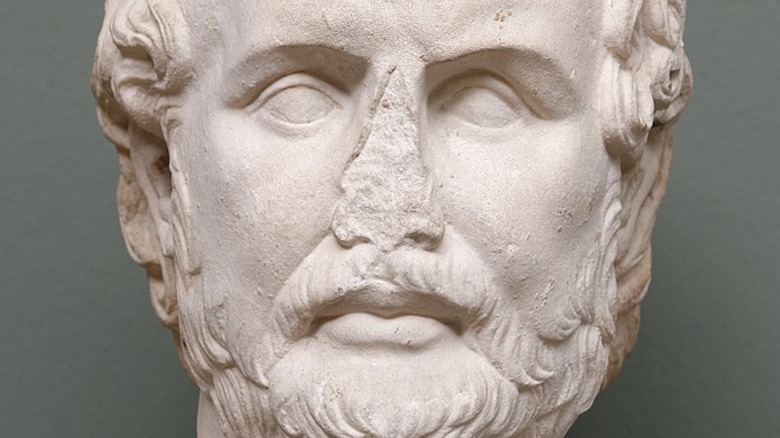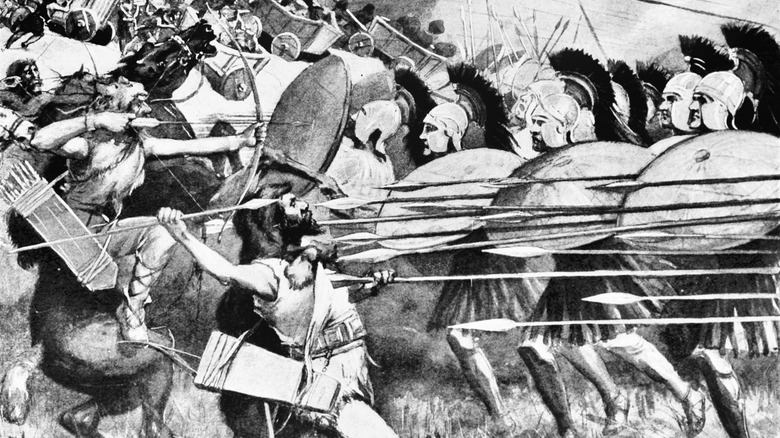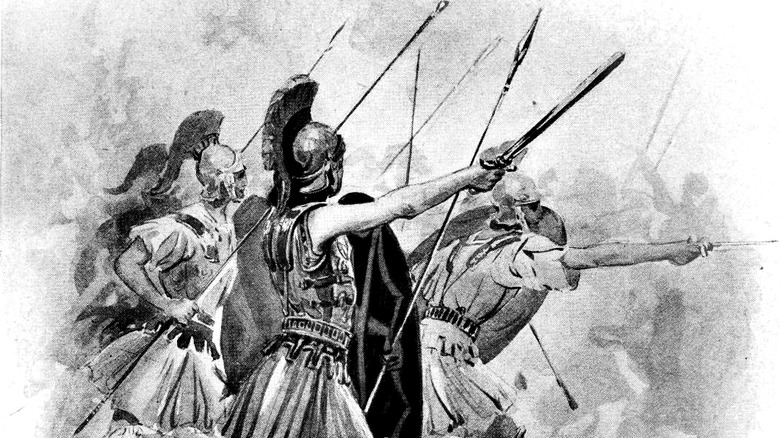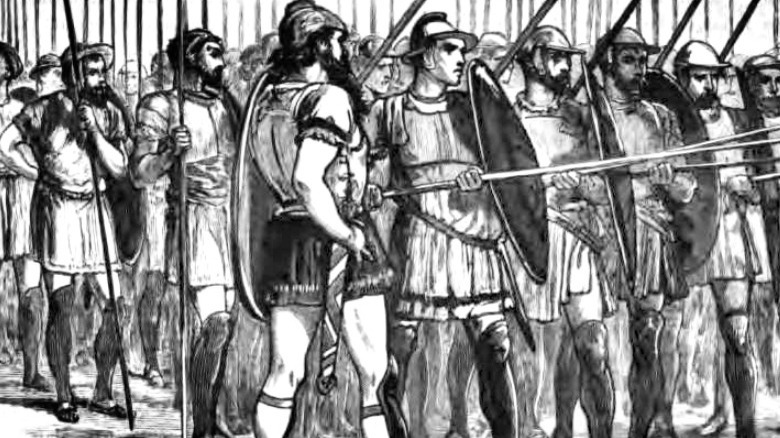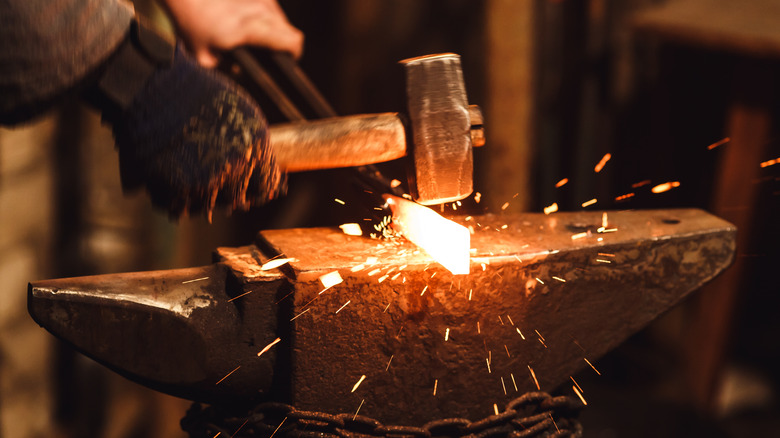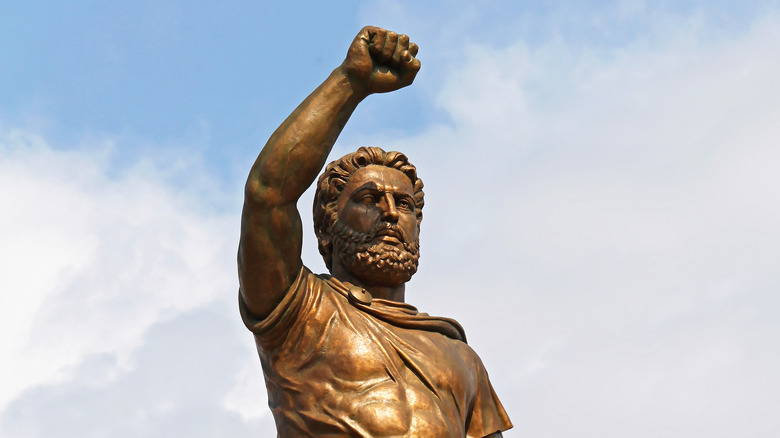Alexander The Great's Father Changed The Military Forever. Here's How
When Philip the II inherited the Macedonian throne at 23 years old in 359 B.C., he faced an external threat to his kingdom (via World History Encyclopedia). The northern borders of his territory were overrun by Illyrian invaders and his army wasn't up for the task (via History Hit).
Believing himself to be a direct descendant of Hercules, the son of Zeus, Philip II was empowered to change the face of warfare. His brief imprisonment by the Thebans exposed him to the organization and military strategies of the great generals Epaminondas and Pelopidas. He drew from these insights while reorganizing his armed forces. Philip II concentrated on improving his infantry. First he standardized and provided weaponry to his soldiers. They were equipped with a smaller, lighter shield and a longer spear. Second, he trained his foot soldiers to employ the phalanx formation (via Weapons and Warfare). Third, he drastically increased the size of his forces to 10,000 or more.
Thanks to his reforms, Philip II drove the invaders out of Macedonia, but he had only just begun to grow his nation and forces into a modern army. Philip II had a chip on his shoulder. The self-proclaimed enlightened Greeks to his south thought him and his people were uncivilized and brutish (via "Philip II of Macedonia: Greater Than Alexander"). To prove his superiority, Philip II turned his now massive force southward and began a historic campaign against his doubters.
From part-time to full-time warriors
Philip II made further innovations to his armed forces in the following decades. Originally, commanders were responsible for training farmers or tradesmen into part-time Greek hoplite soldiers (via World History Encyclopedia). Philip II changed soldiering into a full-time occupation, paid enough for all-year campaigns (via History Collection). The income allowed families to purchase slaves or additional land, supplementing for the absenteeism of the male of the household. No longer was Macedonia defended by farmers conscripted in times of need (via Weapons and Warfare). This was the advent of a professional army of soldiers.
Philip II made additional improvements to the phalanx formation by modifying its components. Each phalanx had an individual commander, which increased the efficiency of communication during battle (via World History Encyclopedia). The length of the dorus spear wielded by rows of foot soldiers was lengthened to a 15-18 foot or 18-20 foot pike called a sarissa. This increased the range and deadliness of the phalanx. Soldiers were further away from the clashing swords of their enemies, decreasing the need for heavy armor. Now the phalanx was a quick-striking force on the front-line of combat.
The army provided uniforms, weapons, helmets, and a xipho, a small, double-edged sword, for its infantry. Numbers continued to grow to around 18,000 men, larger than any Greek poleis (city-state) had been before. These new professional soldiers were named Pezhetairoi, or Foot Companions.
Noble class of warriors
Usually serving as generals in the military, under Philip II the nobility of Macedonian society took on the new role of Hetairori. Hetairori or The Companions were a new breed of heavy cavalry rider made up of the sons of the nobility (via History Collection). The riders were armed with a shorter sarissa adapted to be used from horseback. Unique for the Greek peninsula, they went on to hold their weight against Persian cavalry.
Another specialized group of warriors in Philip II's army was The Royal Guard, or Hypaspists. This new group of specialized soldiers were pulled from different areas of the kingdom. It's still unknown the exact weaponry used, but they were perhaps armed with a large shield, a short spear, and a light sword. Numbering around 3,000 men, Hypaspists received more training/drilling, developing a diverse set of tactics and skills. Possessing a high level of flexibility, they were grouped in small units to increase their mobility on the battlefield. Under the command of Philip II's son, Alexander the Great, they became the "special forces” arm of the military.
Loyalty and organization
Philip II utilized a number of psychological strategies and bribery to obtain the loyalty of his army (via Weapons and Warfare). New training drills were implemented to increase discipline at all levels of the armed forces. An oath of allegiance to the king was now required, making those in the army no longer loyal to a polis or region, but to Philip II (via World History Encyclopedia).
The nobility's new title as Hetairoi or The Companions instilled a social and political dedication to Philip II. It became more evident than ever before that the nobility served at the pleasure of the king and owed their station to him. While forming a psychological bond, this new title and relationship also weakened the influence any one general had in the kingdom.
Territorial battalions were originally united in their ties to their poleis, but now new citizens found their future tied to serving the king and with this partnership they received land, money, and a national source of discipline and training. Philip extended opportunities to citizens considered on the outskirts of his kingdom, bringing them into the fold with promises of land for their fealty. For example, the once wild men of western Macedonia built his heavy infantry. The marriage of territorial and national unity increased unit cohesion and soldier discipline on the battlefield (via History Collection).
The hammer and anvil strategy
Philip II excelled at coordinating complex battle plans which incorporated the strengths of his infantry and cavalry units (via Weapons and Warfare). For example, the decision to switch to a lighter shield from the heavy interlocking shields made his foot soldiers faster than other armies on the battlefield (via History Collection). It's also said that by holding the sarissa aloft in certain ways, the soldiers could provide a misleading perspective to their opponents, concealing their true movements (via World history Encyclopedia).
Mercenaries with special skills served as archers or scouts. He was the first general to create and travel with a Corp of Engineers overseeing light siege units like towers and catapults (via World History Encyclopedia). These units were occasionally employed in battle as artillery. Philip II masterfully implemented new tactics to support his strategies while wielding his units and specialized forces.
Philip II is known for a legendary battle strategy known as the anvil and the hammer (via History Hit). The Macedonian phalanx was the anvil, providing a strong and pointy straight edge in the battle field. They would engage the other infantry and hold them in combat. Once the enemy's infantry was fixed in place, the Hetairoi horsemen would circle around the sides or back of the enemy. The horsemen would then charge in the direction of the phalanx, bringing a metaphorical hammer down on the enemy, pushing their infantry against the anvil.
A legacy of warfare innovation
During his conquest and unification of the Greek peninsula, Philip II's army bloomed in size, with the infantry increasing from 10,000 to 24,000 and the cavalry from 600 to 3,500 (via World History). The synergy of these different units into a cohesive army, supporting a common battle strategy, is considered the biggest revolution of warfare to date (via History Collection). These ideologies still live on in every modern armed force.
According to the book "Philip II of Macedonia: Greater Than Alexander" by historian Richard A. Gabriel, Philip II "saved Macedonia from disintegration, military occupation and eventual destruction by securing it against external enemies, and bringing into existence Europe's first national territorial state." He was one of Greece's greatest generals. After the unification of Greece, his monster army was setting the stage for an attack on the Persians, as payback for their invasion 100 years previous. It was at this point Philip II was assassinated, bequeathing his army to his son, Alexander the Great.
